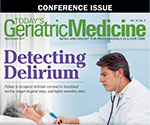 |
A recent study suggests that recommending physical therapy to address the pain of knee osteoarthritis could significantly reduce the costs of treating the condition. However, findings indicate that many physicians embrace the use of corticosteroid injections and pain medications rather than prescribing physical therapy.
In addition to reading our e-newsletter, be sure to visit Today’s Geriatric Medicine’s website at www.TodaysGeriatricMedicine.com, where you’ll find news and information that’s relevant and reliable. We welcome your feedback at TGMeditor@gvpub.com. Follow Today’s Geriatric Medicine on Facebook and Twitter, too.
— Barbara Worthington, editor |
 |
 |
Knee Osteoarthritis Treatment That Doesn’t Follow Guidelines
Comes at a Price
If health care providers treated patients with knee osteoarthritis (OA) according to established guidelines that include physical therapy, researchers say costs of treatment could drop by as much as 45%. Yet too many physicians are prescribing interventions that are not supported by evidence and may even carry extra risk.
An award-winning study published in The Journal of Arthroplasty queried the Humana claims database to determine the prevalence of eight nonsurgical treatment modalities—hyaluronic acid (HA) injections, corticosteroid (CS) injections, physical therapy, knee brace, wedge insole, opioids, NSAIDs, and tramadol—used to treat 86,081 patients with knee OA. The patients were receiving conservative treatment in the year prior to total knee arthroplasty (TKA).
Full story » |
 |
 |
Detecting Delirium
Although delirium has been linked to persistent functional decline, increased length of stay with associated costs, a greater likelihood of nursing home placement, and higher mortality rates, it often goes unrecognized. Read more »
Innovative Methods to Preserve Autonomy
in Patients With Cognitive Decline
Age-related cognitive disorders can lead to the loss of a patient’s rights; however, providers must advocate to preserve dementia patients’ autonomy, when possible. Read more »
Antianxiety Medications
A systematic approach can improve anxiety for patients while minimizing the inappropriate use of benzodiazepines. Read more » |
 |
 |
Partnership, Community Take Center Stage in the Windy City
By Barbara Worthington
The American Society on Aging’s Aging in America Conference was held in Chicago from March 20–24. Sessions designed for providers of aging services from social workers to clinicians addressed topics from caregiving to aging policy. For the second year, the Managed Care Academy highlighted the changing realities of the health care and aging services markets and explored ways community-based organizations can build skills to successfully engage in partnerships with health care organizations.
Throughout the week, various sessions focused on aspects of aging in community, caregiving, clinical care and transitions, diversity and cultures of aging, integrated care networks, lifelong learning, mental health, advocacy and ethics, religion and spirituality, and technology.
Read more » |
 |
|
|
 |
Deadly, Drug-Resistant ‘Superbugs’ Pose Huge Threat
New strains of antibiotic-resistant bacteria have created a huge threat to human health, according to an article in The New York Times.
Increased Risk of 11 Types of Cancer Linked to Being Overweight
A new study indicates that being overweight has been associated with an increased risk of 11 types of cancer, according to an article published in The Guardian.
What Hospitals Waste
Wanton wastefulness results in billions of dollars lost by the US health care system each year, according to an article in The Philadelphia Inquirer.
Snoring May Be Benign, or It May Be a Sign of a Serious Problem
Older adults’ snoring may be more than a simple annoyance to a bed partner, according to an article in The Washington Post. |
 |
 |
PIVO
PIVO, a needle-free vascular access device designed for ease of use, is a single-use disposable device allowing workers to take samples from indwelling peripheral IV lines, reducing the need for repeated sticks or central line access and decreasing risk to patients and providers. It works by advancing a small, flexible catheter through the IV line, from which it can draw lab-quality blood samples. The device enhances the blood draw experience for patients and clinical staff. Learn more »
GOJO SMARTLINK
GOJO SMARTLINK provides alerts for facilities that seek to monitor refill status of GOJO dispensers. The alerts communicate battery life and dispenser status as well, and can be integrated into the SMARTLINK Hand Hygiene Monitoring system. The alerts are part of the SMARTLINK portfolio, which includes an Activity Monitoring System that can measure compliance by facility floor and the GOJO SMARTLINK Observation System, a mobile application that tracks hand hygiene and personal protective equipment metrics. Learn more » |
 |
|
